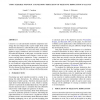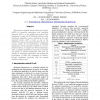92 search results - page 6 / 19 » Adapting simulated behaviors for new characters |
WSC
2007
13 years 10 months ago
2007
Coercion is a semi-automated simulation adaptation technology that uses subject-matter expert insight about model ion alternatives, called flexible points, to change the behavior...
ICC
2008
IEEE
14 years 2 months ago
2008
IEEE
— The combined MIMO with Adaptive Modulation and Coding (AMC) technology can provide high spectral efficiency and link robustness. Moreover, the diversity-multiplexing tradeoff ...
LRE
2006
13 years 7 months ago
2006
Web searchers reformulate their queries, as they adapt to search engine behavior, learn more about a topic, or simply correct typing errors. Automatic query rewriting can help user...
ICRA
2002
IEEE
14 years 15 days ago
2002
IEEE
The use of motor primitives for the generation of complex movements is a relatively new and interesting idea for dimensionality reduction in robot control. We propose a framework ...
ISCC
2009
IEEE
14 years 2 months ago
2009
IEEE
We introduce Adaptive Smooth Simulcast Protocol (ASSP) for simulcast transmission over best-effort networks. ASSP is a new multiple-rate protocol that implements a single rate TCP...


